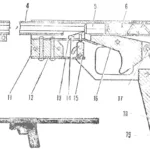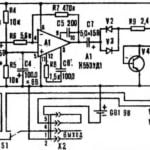Recently born, the guitar has managed to acquire its own history. At first it was a simple hybrid between a conventional housing with a wiring diagram. Then came the so-called “Board”: the whole guitar was a actually one exaggerated upper deck. “Board” has received the widest distribution in the world… and gradually disappointed many musicians.
Still, there was something in the good old corps. Without it, the guitar broke. The sound lost it softness and tenderness, and too tight symbiosis with electronics has led to the fact that the tool has lost the ability to sing in my own voice.
Had to “look back”. Modern guitar — papacostea again has a body, but a special one designed just for her. It is equipped with many electrical and mechanical devices, creating countless musical effects. It is easier to “boards” and finally allowed to play itself, without electrical helpers.
One such musical wonders of the showcased designers and enthusiasts of the North West zone of our country Leningrad D. Medvedovsky and Oleg GUZ. Sparkling crimson beauty was distinguished by elegance and refinement, but possessed highly technical “weapons”.
The designers of the electric guitar won the main prize of the exhibition under section musical instruments.
Creating an electric guitar, we tried to consider all the requirements that apply today to the tools of this type. The guitar is equipped with three sensors universal with adjustable core located under each string, the tone control 9 fixed tones, pre-amplifier, separate volume controls for low, medium and high audio frequencies, a mechanical vibrator, silencer, damper and other devices to obtain even the most delicate musical effects.
In an electric guitar (Fig. 1) consists of the following main units and parts: body, fretboard, headstock with kolcevoy mechanics, mechanical group and the electrical circuit elements.
Body electric guitar hollow. It consists of an upper and lower deck, a combined side wall shell. For details of the case, it is recommended to use high-quality softwood — spruce, pine, Linden, alder. Its humidity should not exceed 8-10%.
First make the blank sides-glued joiner’s glue 2-3 bar. They must be carefully adjusted to each other — otfugovat. Material sizes in mm: length 510, width 410, depth 36.
Then cut the external and internal contours of the shell, and the upper and lower tabs, make cutouts with a width of 10 mm and depth 15 mm. In these cuts for rigidity glued carefully customized rectangular rail cross-section 10 X 15 mm.
Of good-quality plywood with thickness of 3-4 mm but the cardboard template (Fig. 2) cut the deck, bore holes in them and glued to the sides. This operation is very responsible. First of all, you need to prepare both edges of the shell around the perimeter. Carefully handle rasp bonded parts. After this, taking 8-10 clamps or clamps, no glue soundboard customize the shell and make a test clip. Making sure the deck is firmly pressed around the perimeter, coat the surface of carpenter’s glue and leave for 24 hours to dry.
Grif do you have to make hard wood — beech, birch, etc. is Better if it is dual layer, as the load he will have considerable: each string gives the tension up to 12 kg, and the total static load is about 80 kg.
Procurement under the neck has a length of 480 mm, width 50 mm, thickness 45 mm. the Upper part of the neck is flat under the trim strip, which bears the frets and buttons. The panel is made of straps (pear, walnut, mahogany, etc.) with a thickness of 6-7 mm.
The lower part of the neck semicircular, and at the junction of the neck with the body is rectangular. Length of the neck depends on the scale of — the working part of the string, which is determined by the distance from the bottom display sill. In ours, scale is 650 mm and the length of the neck — 480 mm (Fig. 3).
The headstock is also made of solid wood. The shape and size are determined by her kolcevoy mechanics. The fingerboard, headstock and trim, with well-prepared surfaces are glued together. The headstock and fretboard are joined at an angle of 15°.
To seal the finished neck with the body, it is first necessary to identify them longitudinal centerline, and then, combining the centerline and carefully outlining the connection, choose a chisel a notch in the ledge of the shell. Such a connection provides sufficient strength of the tool when the tension of the strings. It must be remembered that the stamp must be affixed to the housing are not parallel and at a slight angle, approximately 1°. It will prolong his life.
The neck is attached to the housing by four screws 40×3.
The layout of the fretboard and installing frets are the most important stages of work.
They require much attention and careful execution, because the correct calculation will depend largely on the voice of guitar.
As mentioned above, scale is 650 mm. Length frets is determined by the formula


